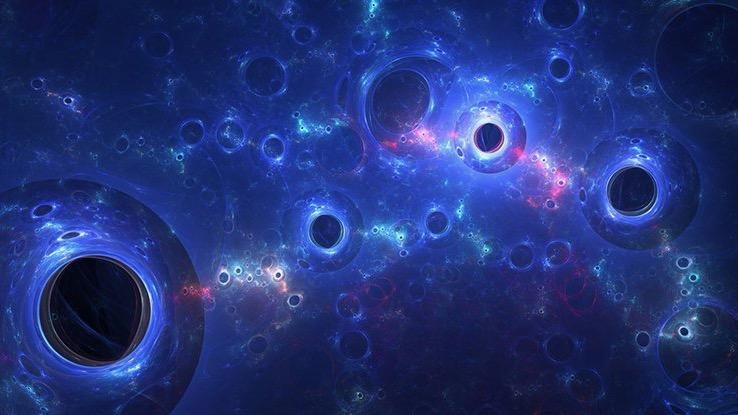- The Elusive Nature of Dark Matter: What We Know So Far
- Theories of Dark Matter: Exploring the Possibilities
- The Hunt for Dark Matter: Current Strategies and Future Prospects
- Dark Matter and the Formation of Galaxies: How They’re Connected
- The Dark Side of the Universe: The Role of Dark Matter in Cosmology
- The Mysteries of Dark Matter: Why Scientists Are So Intrigued
- Dark Matter and the Big Bang: Unraveling the Origins of the Universe
- The Puzzle of Dark Matter: What We Need to Learn to Solve It
- Dark Matter and Black Holes: Uncovering the Links Between Them
- The Dark Matter Debate: Why Some Scientists Remain Skeptical
The Elusive Nature of Dark Matter: What We Know So Far
For decades, scientists have been studying the mysterious substance known as dark matter. It is called “dark” because it does not interact with light and is therefore invisible to telescopes. Despite its invisibility, dark matter is believed to make up about 85% of the matter in the universe, making it a crucial component of our understanding of the cosmos. In this blog post, we will explore what we currently know about dark matter and why it remains such a fascinating and elusive mystery.
What is Dark Matter?
Dark matter is a form of matter that does not interact with light or other forms of electromagnetic radiation, which is why it cannot be directly observed. It was first proposed in the 1930s by Swiss astronomer Fritz Zwicky, who observed that the visible matter in galaxy clusters did not provide enough gravitational force to keep them from flying apart. Zwicky suggested that there must be an additional, invisible form of matter that was providing the necessary gravitational pull to hold the galaxies together.
Since then, scientists have been searching for evidence of dark matter, using a variety of techniques. The most common method is to look for its gravitational effects on visible matter, such as stars and galaxies. By observing how the visible matter in a galaxy moves, scientists can calculate the amount of gravitational force being exerted on it. If this force is greater than what can be explained by the visible matter alone, it is assumed that dark matter is present.
What We Know So
Far Despite decades of research, we still know very little about dark matter. We do know that it is much more abundant than visible matter, accounting for about 85% of the matter in the universe. We also know that it has a gravitational effect on visible matter, which is why we believe it exists.
There are several leading theories about what dark matter might be made of. One possibility is that it is composed of weakly interacting massive particles (WIMPs), which would interact with ordinary matter only through the weak nuclear force. Another possibility is that dark matter is made up of axions, which are hypothetical particles that are extremely lightweight and would interact with matter very weakly.
Despite the many theories, we have not yet been able to detect or directly observe dark matter. This is partly because it does not interact with light or other forms of electromagnetic radiation, and partly because it is not concentrated in one place like a star or galaxy. Instead, it is spread out throughout the universe, making it difficult to study.
Why Dark Matter is Important
Although we cannot see or directly detect dark matter, it is still an essential component of our understanding of the universe. Without it, we would not be able to explain the gravitational effects that we observe in galaxies and galaxy clusters. Dark matter is also believed to have played a critical role in the formation of galaxies and the large-scale structure of the universe.
Additionally, dark matter could have implications for our understanding of particle physics and the fundamental laws of nature. If dark matter is composed of WIMPs or other particles, studying it could help us gain a deeper understanding of the building blocks of the universe.
Theories of Dark Matter: Exploring the Possibilities
Dark matter is a mysterious substance that is believed to make up the majority of the matter in the universe. Despite being invisible to telescopes, its gravitational effects on visible matter have been observed, leading scientists to search for answers about its composition and properties. In this blog post, we will explore some of the leading theories about what dark matter might be made of and how it behaves.
Theory 1:
Weakly Interacting Massive Particles (WIMPs) One of the most popular theories about dark matter is that it is composed of weakly interacting massive particles, or WIMPs. These hypothetical particles are thought to interact with ordinary matter only through the weak nuclear force, making them difficult to detect.
Scientists believe that WIMPs could be produced in the early universe, shortly after the Big Bang. If they exist, they would be moving at relatively slow speeds, allowing them to cluster together and form massive halos around galaxies.
The search for WIMPs has been ongoing for several decades, with experiments looking for evidence of their interactions with visible matter. So far, no definitive proof has been found, but the hunt continues.
Theory 2:
Axions Another theory about dark matter is that it is composed of axions, which are hypothetical particles that are extremely lightweight and would interact with matter very weakly.
Axions were first proposed in the 1970s to explain a problem with the theory of strong nuclear force, but they were later suggested as a possible candidate for dark matter. Scientists believe that axions could be produced in the early universe and would be spread out throughout the cosmos, forming a diffuse “axion field.”
Despite being difficult to detect, axions have been the subject of several ongoing experiments, including the Axion Dark Matter Experiment (ADMX), which is searching for evidence of axion interactions with visible matter.
Theory 3:
Modified Gravity Another possibility is that the observed gravitational effects that we attribute to dark matter are actually the result of a modification to the laws of gravity on a large scale. This theory, known as Modified Newtonian Dynamics (MOND), suggests that gravitational forces behave differently on larger scales than they do on smaller scales.
Although MOND has been proposed as an alternative to dark matter, it has not been widely accepted by the scientific community, and there is little evidence to support it.
The Hunt for Dark Matter: Current Strategies and Future Prospects
Dark matter is one of the most elusive and mysterious substances in the universe. Although we have observed its gravitational effects on visible matter, we still do not know what it is made of or how it behaves. In this blog post, we will explore the current strategies for detecting dark matter and the future prospects for uncovering its secrets.
Current Strategies for Detecting Dark Matter
One of the primary strategies for detecting dark matter is through direct detection experiments. These experiments aim to detect the rare interactions between dark matter particles and visible matter. They typically involve large, sensitive detectors that are located deep underground to shield them from cosmic rays and other sources of background radiation.
Another approach is to search for indirect evidence of dark matter. For example, scientists can look for the products of dark matter annihilation or decay, such as gamma rays or cosmic rays. This approach requires the identification of specific signals that can be distinguished from background radiation.
A third strategy is to use gravitational lensing to study the distribution of dark matter in the universe. This technique involves studying the way that the gravity of dark matter bends the light of distant galaxies, allowing us to map out its distribution.
Future Prospects for Discovering Dark Matter
Despite decades of searching, we have yet to definitively detect dark matter. However, there are many promising avenues for future research.
One of the most exciting prospects is the use of next-generation detectors that are even more sensitive than current ones. These detectors are designed to detect even the smallest signals from dark matter interactions, greatly increasing our chances of detecting it.
Another approach is to study the properties of dark matter through astrophysical observations. For example, studying the way that dark matter interacts with visible matter in galaxy clusters can provide insights into its behavior.
Finally, there is the possibility of discovering new particles or forces that could help us to better understand dark matter. This could involve the discovery of new particles that interact with dark matter, or the identification of new forces that govern its behavior.
Dark Matter and the Formation of Galaxies: How They’re Connected
Galaxies are massive structures that are made up of stars, gas, dust, and dark matter. While we can observe the visible components of galaxies, such as stars and gas, it is the invisible component of dark matter that plays a crucial role in their formation and evolution. In this blog post, we will explore how dark matter and the formation of galaxies are connected.
How does Dark Matter Influence Galaxy Formation?
The role of dark matter in galaxy formation can be understood through its gravitational influence. As dark matter does not interact with electromagnetic radiation, it can only be detected through its gravitational effects. It is the gravity of dark matter that dominates the formation of galaxies, shaping the distribution of visible matter within them.
During the early universe, dark matter was distributed evenly, forming a network of filaments and clusters. Over time, gas and dust began to accumulate within these structures, which eventually led to the formation of the first galaxies. The gravity of dark matter was crucial in this process, as it provided the gravitational pull necessary to bring together the gas and dust into galaxies.
As galaxies evolved, the gravity of dark matter continued to play a central role. It helped to shape the distribution of stars and gas within galaxies, determining their structure and morphology. Additionally, dark matter played a role in the growth of supermassive black holes at the centers of galaxies.
Why is Dark Matter Important for Understanding Galaxy Formation?
The study of dark matter is essential for understanding the formation and evolution of galaxies. Without accounting for the presence of dark matter, our understanding of the universe would be incomplete.
Furthermore, the behavior of dark matter can provide valuable insights into the fundamental nature of the universe. For example, its properties could shed light on the nature of particle physics and the fundamental forces that govern the behavior of matter.
The Role of Dark Matter in Cosmology: Understanding the Universe’s Structure
Cosmology is the study of the structure and evolution of the universe as a whole. One of the most significant questions in cosmology is understanding the nature of dark matter and its role in the universe’s structure. In this blog post, we will explore the role of dark matter in cosmology and how it helps us to understand the universe’s structure.
How does Dark Matter Shape the Universe’s Structure?
Dark matter plays a crucial role in shaping the structure of the universe. The gravity of dark matter acts as a cosmic glue, bringing together gas, dust, and other matter to form galaxies and galaxy clusters. The distribution of dark matter forms a network of filaments and clusters, known as the cosmic web. Visible matter accumulates within these structures, forming the galaxies and galaxy clusters that we observe today.
The distribution of dark matter also affects the large-scale structure of the universe. The gravity of dark matter pulls matter together into dense regions, while the regions with less dark matter are less dense. This creates a pattern of “cosmic webbing” that can be observed in the distribution of galaxies and clusters.
Why is Dark Matter Important for Cosmology?
The study of dark matter is essential for understanding the universe’s structure and evolution. Without accounting for the presence of dark matter, our understanding of the universe’s large-scale structure would be incomplete. Additionally, the properties of dark matter can provide valuable insights into the fundamental nature of the universe.
Dark matter also plays a crucial role in the formation of the first galaxies and stars. During the early universe, the gravity of dark matter brought together gas and dust to form the first galaxies. Without the gravitational pull of dark matter, the universe would be a very different place, and the formation of galaxies and stars would not have been possible.
The Mysteries of Dark Matter: Why Scientists Are So Intrigued
Dark matter is one of the greatest mysteries of modern physics, and scientists are still trying to understand its true nature. Despite decades of research, there is still much we do not know about this elusive substance. In this blog post, we will explore why scientists are so intrigued by dark matter and the mysteries that surround it.
Why are Scientists So Intrigued by Dark Matter?
There are several reasons why scientists are so intrigued by dark matter. First and foremost, dark matter is one of the biggest mysteries of modern physics. Despite decades of research, we still do not know what dark matter is made of, how it interacts with other forms of matter, or why it exists.
Furthermore, dark matter plays a crucial role in the formation and evolution of galaxies. Without the gravitational pull of dark matter, galaxies would not have been able to form in the early universe. Understanding the nature of dark matter is therefore essential for understanding the large-scale structure of the universe.
Finally, the study of dark matter has the potential to revolutionize our understanding of fundamental physics. If we can unlock the secrets of dark matter, we may gain new insights into the nature of the universe, including the fundamental forces and particles that make up the universe.
What are the Mysteries Surrounding Dark Matter?
There are several mysteries surrounding dark matter that scientists are still trying to unravel. These include:
- What is dark matter made of? While we know that dark matter exists, we still do not know what it is made of. Some theories suggest that dark matter is made up of particles that do not interact with light or other forms of matter.
- How does dark matter interact with other forms of matter? While dark matter does not interact with light, it may interact with other forms of matter through the weak nuclear force.
- Why does dark matter exist? While dark matter is essential for the formation and evolution of galaxies, we still do not know why it exists in the first place.
Dark Matter and the Big Bang: Unraveling the Origins of the Universe
Dark matter is an essential component of the universe, and its presence has played a critical role in shaping the cosmos as we know it. In this blog post, we will explore the connection between dark matter and the Big Bang, and how they are intertwined in the origins of the universe.
The Big Bang Theory
The Big Bang theory is the prevailing model of the origins of the universe. According to this theory, the universe began as a singularity, a point of infinite density and temperature, about 13.8 billion years ago. This singularity then expanded rapidly, giving rise to the universe as we know it today.
Dark Matter and the Big Bang
Dark matter played a crucial role in the formation of the universe. As the universe expanded and cooled, matter began to clump together under the influence of gravity. However, the amount of visible matter present in the universe was not sufficient to explain the large-scale structure we observe today, such as the distribution of galaxies and cosmic microwave background radiation. This led scientists to propose the existence of dark matter, which would provide the additional gravitational pull necessary to explain these structures.
In fact, dark matter was present even before the Big Bang. In the moments following the singularity, the universe was filled with a hot, dense plasma of particles that were interacting with each other through various forces. However, dark matter did not interact with this plasma and instead remained a separate component of the universe.
The Origins of Dark Matter
The exact origins of dark matter are still unknown, but several theories have been proposed. One theory suggests that dark matter is made up of weakly interacting massive particles (WIMPs), which are particles that interact only through the weak nuclear force and gravity. Another theory proposes that dark matter is made up of axions, which are hypothetical particles that are extremely light and weakly interacting.
Regardless of its origins, the presence of dark matter has played a crucial role in shaping the universe we observe today. Without dark matter, galaxies would not have formed, and the large-scale structure of the universe would be vastly different.
The Puzzle of Dark Matter: What We Need to Learn to Solve It
Dark matter is one of the most puzzling and mysterious components of the universe. Although we have made significant progress in understanding its effects on the universe, we still have much to learn about its nature and properties. In this blog post, we will explore the puzzle of dark matter and what we need to learn to solve it.
Current Status of Dark Matter Research
Dark Matter and Black Holes: Uncovering the Links Between Them Although we have known about the existence of dark matter for several decades, we still do not know what it is made of. Scientists have proposed several theories to explain the nature of dark matter, including WIMPs, axions, and sterile neutrinos. However, none of these theories have been conclusively proven, and the search for dark matter continues.
What We Need to Learn to Solve the Puzzle of Dark Matter
To solve the puzzle of dark matter, there are several key questions that we need to answer:
- What is dark matter made of? This is perhaps the most fundamental question that we need to answer to understand the nature of dark matter. We need to identify the particles that make up dark matter and understand how they interact with other matter and radiation.
- How is dark matter distributed in the universe? We need to map the distribution of dark matter in the universe and understand how it is related to the distribution of visible matter. This will help us understand how dark matter influences the formation and evolution of galaxies.
- How does dark matter interact with other matter? We need to understand how dark matter interacts with other particles and forces in the universe. This will help us design experiments to detect and study dark matter.
- What is the role of dark matter in the evolution of the universe? We need to understand how dark matter has influenced the large-scale structure of the universe and the formation of galaxies. This will help us understand the history and evolution of the universe.
Dark Matter and Black Holes: Uncovering the Links Between Them
Dark matter and black holes are two of the most fascinating objects in the universe, and recent research has uncovered surprising links between them. In this blog post, we will explore these links and the implications they have for our understanding of the universe.
What is Dark Matter?
Dark matter is a form of matter that does not interact with light and other forms of electromagnetic radiation, making it difficult to detect. However, we know that it exists because of its gravitational effects on visible matter, such as stars and galaxies. Dark matter is thought to make up about 85% of the matter in the universe.
What are Black Holes?
Black holes are regions of spacetime where the gravitational field is so strong that nothing, not even light, can escape. They are formed when massive stars collapse at the end of their lives, and they continue to grow by accreting matter from their surroundings.
The Link Between Dark Matter and Black Holes
Recent research has suggested that there may be a link between dark matter and black holes. One theory proposes that dark matter particles may accumulate in the centers of galaxies and form a dense core that triggers the formation of a black hole. This would explain the presence of supermassive black holes in the centers of most galaxies.
Another theory suggests that black holes may be able to capture and accumulate dark matter particles. This would make black holes an important component of dark matter halos, the invisible regions of space where dark matter is thought to be most concentrated.
Implications for Our Understanding of the Universe
The links between dark matter and black holes have important implications for our understanding of the universe. If dark matter particles do accumulate in the centers of galaxies and trigger the formation of black holes, it would provide further evidence for the existence of dark matter and help us understand its properties and behavior.
Similarly, if black holes are able to accumulate dark matter particles, it would provide new insights into the nature of black holes and their role in the formation and evolution of galaxies.
The Dark Matter Debate: Why Some Scientists Remain Skeptical
Dark matter is a hotly debated topic in the field of astrophysics, with some scientists remaining skeptical of its existence. In this blog post, we will explore the reasons behind this skepticism and the ongoing debate over the nature of dark matter.
Reasons for Skepticism
Despite the evidence for the existence of dark matter, some scientists remain skeptical. One reason for this skepticism is the lack of direct observational evidence. Dark matter cannot be directly detected because it does not interact with light or other forms of radiation, which makes it difficult to study.
Another reason for skepticism is the possibility that our understanding of gravity may be incomplete. Some scientists have proposed alternative theories of gravity that could explain the observed effects attributed to dark matter without the need for an invisible form of matter.
Finally, some scientists argue that the evidence for dark matter may be the result of other phenomena that we do not yet understand, such as the behavior of gas and dust in galaxies.
The Dark Matter Debate
The debate over the nature of dark matter is ongoing, and scientists are actively researching new ways to test its existence and properties. One approach is to search for indirect evidence of dark matter through its gravitational effects on visible matter, such as stars and galaxies.
Another approach is to look for dark matter particles directly through experiments on Earth. These experiments involve searching for collisions between dark matter particles and atoms in detectors.












